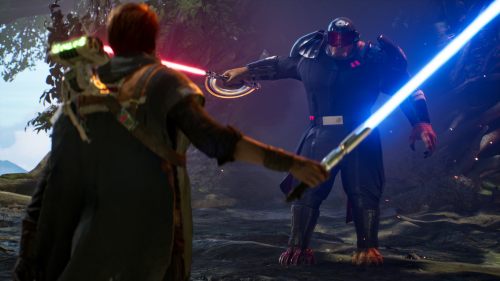WHAT REMAINS OF EDITH FINCH Game Review: You Don’t Turn Your Back On Family
I first played What Remains of Edith Finch back at Fantastic Arcade 2015. At the time, only a tiny, rough sliver was playable; it was impossible to tell what the hell the game was. Now it’s finished, and it’s clear what we’re dealing with. As you’d expect from a game developed by The Unfinished Swan’s Giant Sparrow and distributed by Annapurna Interactive (a newly-formed subsidiary of Megan Ellison’s Annapurna Pictures), it’s not a shooter, but a first-person exploration game along the lines of Gone Home or Everybody’s Gone to the Rapture. It’s also kind of terrific.
Indeed, Edith Finch opens almost winkingly like Gone Home: a woman returns to a long-unseen family home, abandoned seemingly in the middle of the night. The house in question is impossibly tall and precarious, perched on a cliff on an island on the East Coast, possessed of numerous bedrooms, staircases, and - in classic video game fashion - secret passages. Filled with books, photographs, and discarded kitchenware in remarkably good nick, it’s a memory tomb waiting to be raided. Therein lies the sprawling story of Edith’s multigenerational family. But it’s a rocky road to familial enlightenment, because spoiler alert: everybody in the family is dead.
Each relative’s tale unfolds via a visit to their old bedroom and a gameplay vignette - more self-contained than Gone Home’s interconnected tapestry, but also more individually memorable. These stories unfold through a variety of in-game media: letters, memories, journals, suicide notes, photo albums, Viewmaster slides, comic books, and even video games, each exploring different gameplay ideas to tell vastly diverse stories. You’ll photograph a family trip that forms a particularly sad part of Edith’s family history; you’ll live out the daydreams that led swathes of Finch children to their deaths; at one point, you’ll play through a living comic book in a fun riff on Creepshow and Halloween. There’s a lot of variety here, both in gameplay and emotional content. So many stories; so many ways of telling them.
As varied as it is, the gameplay in Edith Finch never quite reaches its potential. Nobody’s asking for a complex RPG or anything, but the game doesn’t always make the most of its interactive medium. For the most part, this is a two-stick, one-button affair, with the application of that button changing from scene to scene. When it works, it works great, but too often we’re simply advancing to the next piece of narration, rather than influencing the scene in a meaningful way. One sequence, however, stands apart: a setpiece wherein you play a wastrel twentysomething as he simultaneously chops fish in a cannery and daydreams an epic fantasy tale with himself as the hero. Its simple, repetitive movement and split-focus controls tell the story all by themselves; the joyous and horrific artwork just ramp up its brilliance - and its sadness.

Perhaps the most video-gamey element of Edith Finch is the pause screen - an in-game family tree, with names that get ticked off as you uncover their stories. Reducing the family to a to-do list is extremely video games - while it makes for a convenient measure of progress, it’s not particularly flattering to the stories being progressed through.
It’s always intriguing which details leap out and feel true in a piece of fiction. Edith Finch is full of tiny observations - in the drama, and particularly in the environmental design. For some, the details that grab will be the matriarch’s bird-naming convention: Burpy, Purply, Lurpy, Durpy, Furpy, and Zurpy. For others, it’ll be the hoarded bags of potting mix, the uncomfortable trappings of a child star’s bedroom, or a lifelong doomsday prepper’s bunker that reveals stunted emotional growth. Some might even get a tickle from the game’s unsubtle nods to The Unfinished Swan. For me, it was the brass trim and mottled windows in great-grandmother Edie’s bathroom - a simple touch of interior decor that took me back to my own grandmother’s house. In a game like this, that kind of truth-telling is important, and Edith Finch excels at it.
On the surface, all those details serve only to heighten tragedy. Said to be beset by a curse, the Finch family tree is remarkable for the number of lives cut short before their time. As you uncover a century-plus of escalating tragedy - child, animal, even infant deaths - it’s tempting to agree with the characters who give in to pessimism and fear. After all, as one character says, spend enough time in the shadows, and “even a monster on the other side of the door starts to feel normal. Almost friendly.” Anyone who’s struggled with mental illness can probably identify with that.
But What Remains of Edith Finch isn’t some Batmanny trudge through a peat-bog of dead kids and deader parents. It’s about learning and letting go respectfully, finding love and tranquility and even joy in death. Though much of it deals with a connection to the past, it’s not treated as an anchor: stories are ultimately presented as something we gift onwards to the future. Death can tell us as much about a person as their life, but one needn’t wallow in tragedy to achieve personal growth from it. One need only tell and listen to stories - they’re what our lives are made up of, after all.
There’s plenty of tragedy in What Remains of Edith Finch, but it’s ultimately life-affirming: a game filled with delight and sorrow, and one that fits comfortably in Annapurna’s stable of smart, thoughtful storytelling.



